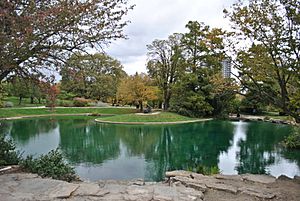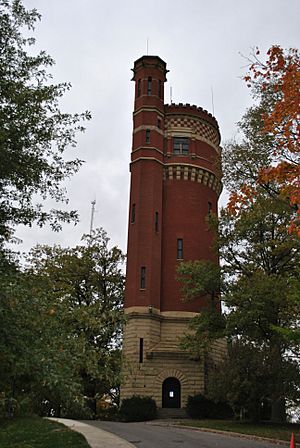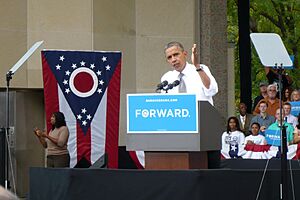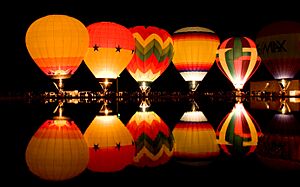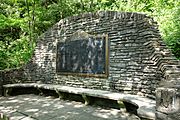Eden Park (Cincinnati) facts for kids
Eden Park is a large city park located in the Walnut Hills and Mt. Adams neighborhoods of Cincinnati, Ohio. This hilltop park covers about 186 acres (that's like 140 football fields!). From many spots in the park, you can see amazing views of the Ohio River valley.
Contents
Park History
The city bought the land for Eden Park in 1869 from a man named Nicholas Longworth. He was a famous gardener and used to grow grapes for wine on this land. Nicholas Longworth loved his land so much, he called it the "Garden of Eden," just like the famous garden from the Bible. That's why the park is still called Eden Park today!
A talented landscape architect named Adolph Strauch designed the park. He also designed the beautiful Spring Grove Cemetery in Cincinnati.
For many years, the park had a huge reservoir that held 96 million gallons of water. It was built between 1866 and 1878. A special building called the Eden Park Station No. 7 pumped water from the Ohio River into this reservoir. Then, the water went into the Eden Park Stand Pipe, which helped send water to homes. In the 1960s, the reservoir was removed. Now, that area has a pretty reflecting pool called Mirror Lake and some baseball fields. You can still see parts of the old water system, like the dam, the pumping station, and the stand pipe.
Cool Places and Buildings
Eden Park is home to many interesting buildings and features.
Elsinore Arch
The Elsinore Arch was built in 1883. It looks like a castle entrance and is a grand way to enter the park.
Spring House Gazebo
The Spring House Gazebo was built in 1904. It's the oldest building still standing in any Cincinnati park! This gazebo is so important that it's even in the logo of the Cincinnati Park Board. The main office for the Park Board is also located near the park's entrance on Gilbert Avenue.
Art and Entertainment
The Cincinnati Art Museum is located right in the park. You can walk from the Elsinore Arch to the museum using a long set of steps through the woods. The Art Academy of Cincinnati used to be next to the museum but has since moved.
If you like live shows, Eden Park has two great spots. The Cincinnati Playhouse in the Park is a theater where you can watch plays. The Seasongood Pavilion is an outdoor stage built in 1959. It's named after a former Cincinnati mayor, Murray Seasongood, and hosts many outdoor concerts and events.
Krohn Conservatory
The Krohn Conservatory is a beautiful greenhouse filled with plants. It was finished in 1933 and has a cool mix of old-style (Gothic Revival) and modern (Art Deco) designs. From the conservatory, you can walk up another set of Cincinnati steps to the Presidents' Grove trail. This trail has trees planted to honor U.S. presidents. The very first tree, an oak, was planted in 1882 for George Washington.
Twin Lakes Area
The Twin Lakes area is a peaceful spot with two lakes connected by a footbridge. This area used to be a quarry where stone was dug out. Near the bridge, you'll find a group of buckeye trees. The buckeye tree is the official state tree of Ohio!
You can also see some interesting statues at Twin Lakes. One is a copy of the Capitoline Wolf Statue, which was a gift from the city of Rome. Another statue shows a cormorant fisher, a gift from Cincinnati's sister city, Gifu, in Japan. Two buildings at Twin Lakes, a snack stand and a restroom, were built in 1937 by the Civilian Conservation Corps (CCC), a group that helped people find jobs during the Great Depression.
Overlooks and Monuments
A road from Twin Lakes leads past the Vietnam Veterans Memorial. It then goes over the old Melan Arch Bridge to the Eden Park Overlook, which is near the park's highest point. From here, you get an amazing view of the Ohio River and the state of Kentucky. The Ohio River Monument also stands here. It was dedicated in 1929 by President Herbert Hoover to celebrate how the river was made easier for boats to travel on all year long.
Park Events
Eden Park hosts many fun events each year. The "EdenSong Music Series" happens every Friday in July at the Seasongood Pavilion. It features live music and is sponsored by the Cincinnati Park Board and the Queen City Balladeers.
Every November, Eden Park also hosts "Balluminaria." This is one of the biggest events in the country where many hot air balloons light up and glow in the dark!
Gallery
-
Cincinnati Art Museum in Eden Park
-
World War I Memorial bench & plaque



